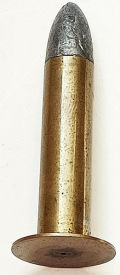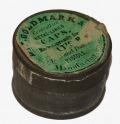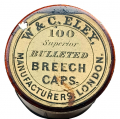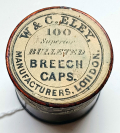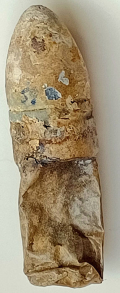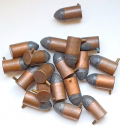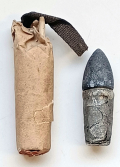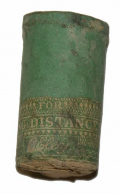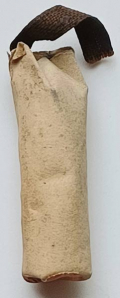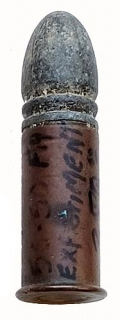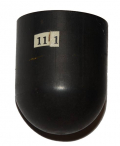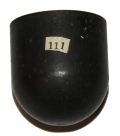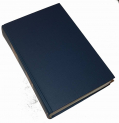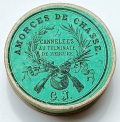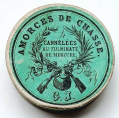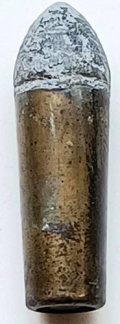site search
online catalog
Firearms
Showing 151 to 200 out of 275
ALL-METAL RING TRIGGER PERCUSSION DERINGER
These small, unmarked, all-metal single action and singe-shot percussion pistols are the product of Bacon and Company of Norwich, CT, and manufactured in very small numbers from about 1852 to 1858, by… (490-7034). Learn More »
EARLY YORK COUNTY POWDER HORN
This is an early, classically York County style powder horn with two incised lines running around the top edge of the lathe-turned, convex base plug mirroring the two parallel incised lines along the… (490-6904). Learn More »
.35 CALIBER MAYNARD CARTRIDGE WITH COPPER RIVETED DISK
Dr. Edward Maynard held patent #22,565 dated January 11, 1859. By this patent, cartridge cases for the Maynard carbine were made of drawn brass to form a tube with a closed end. A brass disk was… (1212-186). Learn More »
NEW YORK CONTRACT REMINGTON ROLLING BLOCK WITH RACK NUMBERS
In the search for new metallic cartridge arms after the Civil War the U.S. government went with the trapdoor system, but New York went with the Remington rolling block, which was popular elsewhere in… (172-5976). Learn More »
RARE HANOVERIAN TIGE-RIFLE BULLET MOLD
This is a two-piece, scissor-type bullet mold made of brass. The two halves are held together with an iron pin. One arm is marked with a “2”. The mold measures 7.25” long overall. Brass exhibits… (1211-256). Learn More »
SPANISH AMERICAN WAR SHELL CASING FROM SALUTE FOR COL. C.H. WIKOFF, HIGHEST RANKING US OFFICER KILLED IN ACTION IN THE SPANISH AMERICAN WAR - SAN JUAN HILL
This fired brass shell casing was kept as a memento from the funeral of the highest-ranking U.S. officer killed in action in the Spanish-American War and comes with a period pencil note reading:… (1240-14). Learn More »
VERY NICE “DERRINGER” SINGLE SHOT PISTOL
The term “derringer” became a generic misspelling during the reporting of the Lincoln assassination, which was committed with a concealed Philadelphia Deringer. Many copies of the original… (172-6009). Learn More »
RARE REMINGTON ELLIOTT US NAVY CARTRIDGE CONVERSION, ENGRAVED
This is a rare Remington, one of just 1,020 Remington percussion Navy revolvers altered to .38 caliber centerfire for the government by Remington in 1875. This is to be distinguished from five or six… (431-67). Learn More »
P.S. JUSTICE RIFLE MUSKET
This a very good example of the .69 caliber rifle musket made in Philadelphia by P.S. Justice at the beginning of the Civil War. The mounts are brass: nose cap, three convex, clamping barrel bands,… (1179-086). Learn More »
SCARCE EARLY WAR .44 CALIBER JOHNSTON & DOW CARTRIDGE
This is a .44 caliber revolver cartridge by Johnston & Dow of New York in excellent condition. Johnston & Dow received patent #33,393, #34,061, and #35,687 dated October 1, 1861, January 7,… (2024-1287). Learn More »
LARGE TWO-SIDED, 26-CAVITY IRON RIFLE BALL MOLD
Very large iron hinge-type mold to cast 26 lead round balls. Twelve cavities on top and twelve on the bottom. Each side is complete with its own funnel/sprue cutter. Cavities measure approximately… (236-1007). Learn More »
GOLDMARK PERCUSSION CAP TIN FOR COLT BELT AND POCKET PISTOLS
Plain unfinished tin with label; measures approximately 1” tall x 1.5” in diameter. The body of the container has very nice tin finish with no rust. Lid has green paper label that reads “D [_]… (490-6899). Learn More »
$295.00
ON HOLD
SCARCE LEMAN MILITIA RIFLE
This is a very good example of a scarce rifle. Henry E. Leman made just 300 or so rifles of this pattern, including some variations. This is all original and complete with ramrod, sights, bands,… (490-6825). Learn More »
SHARPS AND HANKINS NAVY CARBINE
This is a good example of the single-shot, breech-loading .52 Caliber rimfire Sharps and Hankins Navy Carbine, also known as the Second Model or Model 1862, complete, all original, and showing some… (1224-01). Learn More »
US NAVY HOLSTER FOR 1895 DOUBLE ACTION COLT
This holster pattern was adopted by the Navy in 1889 for the new .38 Caliber double-action revolvers ordered that year, most of which were returned to Colt for alteration to the Model 1895 cylinder… (431-72). Learn More »
HOLSTER FOR M1861 COLT NAVY OR M1860 ARMY
This is a military non-regulation holster, unmarked, and typical of those purchased privately by officers or making their way into service by way of early war state troops and in the case of… (431-73). Learn More »
ADJUSTABLE BRASS POWDER MEASURE
This is an adjustable powder measure about 3 ½ inches long overall, made of brass, fitted with a small steel heart-shaped or winged thumbscrew at the bottom to adjust the interior rod fitted with a… (2024-160). Learn More »
$95.00
SOLD
VERY NICE CONDITION EARLY CIVIL WAR U.S. CAVALRY HOLSTER
This is a very good condition early-war holster for a .36 caliber revolver with full military flap, wide belt loop secured by stitching and three rivets, toe plug, and sewn latch tab. The stitching is… (286-1332). Learn More »
COLT MODEL 1877 DOUBLE ACTION .38 CAL. LONG BARREL LIGHTNING REVOLVER
Lots of original blue and some case colors with immaculate checkered hard rubber grips with the rampant colt at top on either side, about excellent condition. Long barrel version with ejector. Barrel… (490-5575). Learn More »
VERY RARE FULL TIN OF “BULLETED BREECH CAPS” BY W. & C. ELEY, LONDON
Offered here is a very fine condition japanned tin filled with 100 “bulleted breech caps.” A printed paper label on the lid reads, “100 Superior BULLETED BREECH CAPS. / W. & C. ELEY,… (2024-125). Learn More »
VERY RARE FULL TIN OF “BULLETED BREECH CAPS” BY W. & C. ELEY, LONDON
Offered here is a very fine condition japanned tin filled with 100 “bulleted breech caps.” A printed paper label on the lid reads, “100 Superior BULLETED BREECH CAPS. / W. & C. ELEY,… (2024-124). Learn More »
"DUG" .58 CALIBER RIFLE MUSKET CARTRIDGE BY JOHNSON & DOW
Johnson & Dow received patents #33,393, #34,061, and #35,687 dated October 1, 1861, January 7, and June 24, 1862 for their cartridges. Using paper or fabric that was treated to make it… (236-944). Learn More »
YORK COUNTY POWDER HORN
An elegant powder horn. From the size, a priming horn (approx 8" in length). Pleasing cream colored body shading to a greenish brown at the spout. The base is convex, lathe turned to produce incised… (480-354). Learn More »
12MM PINFIRE CARTRIDGE BY CHARLES FUSNOT
These are cartridges for the Lefaucheux revolver. This is the “short” pinfire cartridge; with lead bullet seated into a copper case with a stout pin protruding from the bottom edge. This features… (M19951). Learn More »
.442 WESTLEY RICHARDS “MONKEY TAIL” CARTRIDGE
This specimen is a very nice regulation paper wrapped skin cartridge for the British “Monkey Tail” rifles. This one is wrapped in tan paper. Cloth tear strip sticking out of the bottom end. Very… (1212-40). Learn More »
.442 WESTLEY RICHARDS “MONKEY TAIL” CARTRIDGE – BLUE PAPER
This specimen is a very nice paper wrapped skin cartridge for the British “Monkey Tail” rifles. This one is unusual as it is wrapped in blue paper (typically tan paper). Cloth tear strip sticking… (1212-54). Learn More »
EARLY BIRD-SHOT CARTRIDGE FOR 16-GAUGE SHOTGUN
Offered here is an early and interesting shot cartridge. 16-gauge cartridge with powder and shot contained in an outer paper wrapper. Cloth tear strips provide access to the cartridge. An orange label… (1212-138). Learn More »
US MODEL 1840 POMEROY CONTRACT MUSKET RIFLED AND SIGHTED
The US Model 1840 musket is complicated in nomenclature and production details. Initially designated the Model 1835, it was finally designated the 1840 and collectors occasionally call it the Model… (490-4171). Learn More »
SCARCE .36 CALIBER TINFOIL CARTRIDGE BY ELEY, LONDON
This is a very rare cartridge dating to before the Civil War. Made by Eley Brothers in London, this is a .36 caliber pistol cartridge with a tinfoil powder case. The cartridge was then packed in a… (1212-101). Learn More »
US WORLD WAR TWO M-1A1 PARATROOPER CARBINE SCABBARD
Scabbard was designed solely for the M-1A1 folding stock carbine. Made of OD Green canvas the scabbard was slightly padded with a flap at top that was fastened by two lift-dot fasteners. The rear has… (1216-21). Learn More »
LEATHER HOLSTER WITH VERBAL ID TO 17TH & 56TH NORTH CAROLINA CAPTAIN
Small black leather holster made for a small model pistol like a Colt pocket or Bacon revolver. Leather is very thin but in good supple condition. Outer flap has a 5.00 inch long strap sewn to the… (1179-533). Learn More »
VERY NICE ELEY’S WIRE SHOT
A colorful paper container with printed advertising and labels. Round label on the end reads, “ELEY’S / Improved Patent Wire Cartridge / No. 1”. Contains a wire “basket” filled with shot.… (1219-09). Learn More »
WINCHESTER .38-55 BULLET MOLD
Iron scissor-type mold to cast a lead .38 caliber ball for the Winchester rifle. Single cavity mold with spout and a sprue cutter mounted on top of the mold blocks. Turned wood handles with brass… (160-203). Learn More »
CIVIL WAR OFFICER’S BELT HOLSTER
This belt holster was made for a small revolver, likely a “pocket model” of some sort, very typical of those carried by infantry line officer as a sidearm for personal defense in addition to the… (1179-628). Learn More »
.36 CALIBER (84 GUAGE) ENGLISH REVOLVER CARTRIDGE IN ENVELOPE – ELEY, LONDON
Perfect example of a hard-to-find cartridge. This fine specimen is still encased in its protective outer wrapper, with orange label, and brown cloth pull tab. Many English revolvers from Adams, Kerr,… (1212-112). Learn More »
VERY RARE .50-50 EXPERIMENTAL CARTRIDGE – FRANKFORD ARSENAL
This is a .50 caliber copper rimfire cartridge. One of many profiles and sizes experimented with at the Frankford Arsenal following the Civil War. The search was for the most appropriate bullet,… (1212-146). Learn More »
ENGLISH PERCUSSION CAP PACK
This is a “pulp bag” of percussion caps as manufactured at the Royal Laboratory at Woolwich, England. Each pack was to contain 15 copper percussion caps. Packages are full of caps and twisted… (2023-2737). Learn More »
DRUM CONVERSION OF A STATE OF VIRGINIA SWAN CONTRACT MUSKET MARKED “VA. REGT. FAUQUIER” WITH CUT DOWN STOCK
In 1795 Virginia advertised for a contract to procure 4,000 muskets per annum. Colonel James Swan of Boston offered in September of 1796 to supply 4,000 musket per year for five years for a total of… (1000-245). Learn More »
$3,025.00
Originally $3,800.00
.69 CALIBER POWDER CHARGE – GRAY PAPER
This powder charge is in very good condition. Measures 2” long. Fine gray cartridge paper is tied closed at both ends, however there is also a typical folded tail. A blank musket charge that could… (1212-176). Learn More »
18MM (~.70 CALIBER) CARTRIDGE FOR ALTERED SWISS RIFLES
This cartridge is in excellent condition. Measures 1.9” long. Lubricated over bullet with end tucked into the bullet cavity. These “expanding ball” cartridges were for the Swiss Model 1842… (1212-184). Learn More »
POWDER MEASURE ONCE OWNED BY J. HOWARD WERT
Made of tin this unusual item is listed in Wert’s catalog as a powder measure. It measures 1 5/8 inches deep with a rounded bottom and is 1 ¼ inches in diameter. It has the catalog number 111 on… (224-796). Learn More »
POWDER MEASURE ONCE OWNED BY J. HOWARD WERT
Made of tin this unusual item is listed in Wert’s catalog as a powder measure. It measures 1 ¾ inches deep with a rounded bottom and is 1 1/2 inches in diameter. It has the catalog number 111 on… (224-795). Learn More »
BOOK – SPECIFICATION AND DRAWINGS OF CARTRIDGES FOR SMALL ARMS, PATENTED IN THE UNITED STATES PRIOR TO JANUARY 1, 1878
This is a reprint of the original 1878 edition that was in the collection of Herschel Logan. A high-quality reprint from Armory Publications. 7.5” x 11” x 2.5”, unpaginated. Approximately 300… (236-724). Learn More »
PASTEBOARD PACKAGE OF FRENCH PERCUSSION CAPS
Here is a very nice French pasteboard percussion cap container, unopened and full of caps. Round package made of white pasteboard with green paper labels affixed. A white paper label was pasted along… (1212-250). Learn More »
PASTEBOARD PACKAGE OF FRENCH PERCUSSION CAPS
Here is a very nice French pasteboard percussion cap container, unopened and full of caps. Round package made of white pasteboard with green paper labels affixed. A white paper label was pasted along… (1212-210). Learn More »
VERY SCARCE 1799-1800 SWAN CONTRACT VIRGINIA MILITIA REGIMENTALLY MARKED MUSKET: 42nd REGIMENT, PITTSYLVANIA
This musket is stamped “42. VA. REGT. PITTSYLVANIA” on the barrel, was later altered to percussion and then shortened for use in the civilian market. It is a scarce survivor from muskets delivered… (1000-241). Learn More »
MODEL 1841 HALL BREECHLOADING RIFLE: A SCARCE RIFLE, MADE IN PERCUSSION, AND THE LAST OF THE BREED
The breechloading Model 1841 Hall rifle retained the .52 caliber 32 5/8” rifled barrel of the Model 1819, but finally caught up with Hall carbines in the use of percussion priming. These are fairly… (490-3498). Learn More »
THUER’S PATENT .36 CALIBER “POCKET NAVY” CARTRIDGE
This is a Thuer’s Patent metallic centerfire cartridge. This short .36 caliber cartridge is in excellent original condition and was for the Colt Thuer conversion “Pocket Navy” revolver. These… (1212-24). Learn More »
REPRODUCTION SET OF CRISPIN CARTRIDGES
This is a cased display set of reproduction Crispin cartridges as given out at the 2005 California Cartridge Collectors Show. Foam-filled plastic case holds five different Crispin cartridges made for… (1212-251). Learn More »
SCARCE MODEL 1841 SPRINGFIELD CADET MUSKET, DATED 1844
Model 1841 Cadet Musket was produced at Springfield Armory between 1844 and 1845. This is one of only 450 of these weapons produced. Intended for the Corps of Cadets at West Point. This is a .57… (1000-138). Learn More »
$6,800.00
Originally $8,500.00
Showing 151 to 200 out of 275
Most Popular
Historical Firearms Stolen From The National Civil War Museum In Harrisburg, Pa »
Theft From Gravesite Of Gen. John Reynolds »
Selection Of Unframed Prints By Don Troiani »
Fine Condition Brass Infantry Bugle Insignia »
Large English Bowie Knife With Sheath 1870’S – 1880’S »
Imported (Clauberg) Us Model 1860 Light Cavalry Officer's Saber »
featured item
NON-REGULATION SILVER GRIPPED PRESENTATION SWORD BY SCHUYLER, HARTLEY & GRAHAM - LT. JAMES MOFFAT, 16TH NEW YORK CAVALRY
This presentation sword has very impressive deeply cast and chased mounts and silver gripped hilt. Schuyler, Hartley and Graham assembled and sold a wide variety of swords that were often highly embellished and upgraded from regulation patterns, to… (870-653). Learn More »





